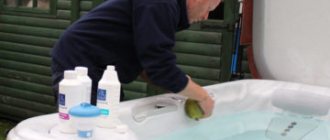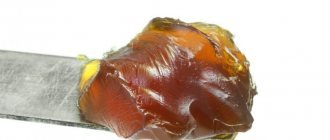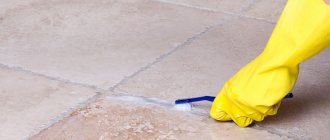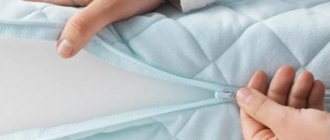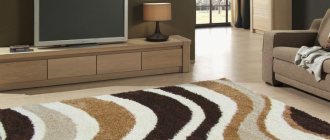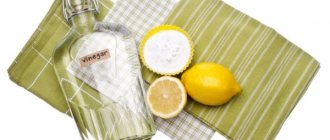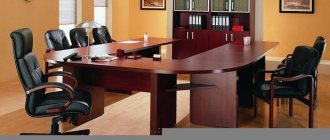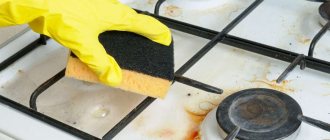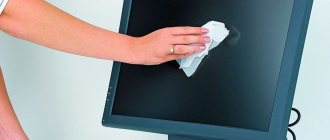Kitchens made from modern materials are valued for their beauty and a wide range of colors to suit every taste. At the same time, before buying, few people think about how to wash the glossy facade of the kitchen and how to care for such furniture. Such a set requires special care so that the surface does not become covered with scratches and stains.
We will tell you about the features of maintaining the beauty of different types of gloss in our article.
With proper care, a glossy kitchen will retain its aesthetic appearance for a long time.
Types and features of coatings
Manufacturers of kitchen sets and countertops successfully combine various materials. Most often it is chipboard or MDF, laminated (painted). Acrylic paint coatings compete with plastic, and decorating with cheap PVC film helps change the appearance beyond recognition. This is how moisture-resistant, durable stone, natural wood, and futuristic slabs are created.
Each material has both strengths and weaknesses. Accordingly, specific cleaning agents are used for them.
Plastic
The use of cheap, durable and unpretentious plastic elements in the manufacture of furniture minimizes the risk of somehow damaging cabinets and cabinets if handled carelessly. Polymers are not afraid of water, can withstand contact with hot dishes, and do not fade. Another advantage of the material is the low weight of plastics: in comparison with metal and wood, they are much lighter, without loss of overall rigidity and reliability.
Dye
The traditional method of processing facades is painting, used to create durable, abrasion-resistant coatings on the surfaces of pressed MDF boards. According to the technology, a paint layer is first applied, and then a varnish is applied (to create a glossy effect). Some difficulties lie in the increased requirements for preparing the base: the absence of potholes, gaps, and roughness. This is ensured by repeated grinding of the material with abrasives and sandpaper.
PVC film
A polymer film applied to the surface of the material by pressing is a budget solution. The consumer can choose white, blue, red, black and other colors to his taste, of which the manufacturer has plenty in stock.
The advantages of the material are wear resistance, strength, and low cost.
But it is better to avoid contact with water - PVC coating is sensitive to it, especially at unprotected joints and edges.
Acrylic
Acrylic materials are polymer materials, which means they are fully endowed with the advantages and disadvantages of plastics. The method of applying a layer of plastic to the main surface is gluing. The coating is durable and easy to maintain.
See also
Instructions for cleaning coffee machines from different manufacturers and the best products
But when choosing a detergent, you should avoid aggressive compounds - they will destroy the gloss of the surface.
Painted MDF with varnish
MDF is considered a hygroscopic material; without special protection, the board quickly becomes saturated with moisture and collapses. To do this, it is painted and coated with a special varnish. The coating will protect MDF, but at the same time it is sensitive to abrasives and aggressive compounds.
Home Remedies
Unfortunately, most folk remedies are not suitable for treating glossy facades. Even soda, a universal and harmless cleaning agent, can damage the shiny layer. Not only can it not be used to clean gloss, but it can also not be added to other cleaning compositions.
Soap solution - a universal means for washing glossy furniture
But there is still some choice of funds available on the farm:
- Soap solution . Bar soap, grated or cut into small shavings, dissolves in warm water. A soft sponge is moistened in this composition, and problem areas are cleaned with it. This method is suitable for removing grease stains and for regular wiping for preventive purposes.
- Mustard . Either a natural product or its powder, diluted with water to form a paste, is suitable. Used as a gel product - applied to the contaminated area in a thin layer. After waiting for a few minutes, wash off with a damp sponge.
- Hydrogen peroxide . Its 3% solution removes grease and old dirt, and also has an antibacterial and disinfectant effect.
Popular traditional cleaners - vinegar and citric acid - are not recommended for glossy finishes.
Main causes of pollution
The kitchen is a potential source of pollution. Grease, food debris, temperature changes from the hob, oven, evaporation - these factors negatively affect furniture. Even fingerprints on the gloss are visible to the naked eye. Using gas burners also leaves greasy soot on cabinet furniture. Therefore, it is impossible to do without cleaning and caring for materials.
Fever
It is impossible to prepare breakfast or a serious lunch for a large family without using a stove. This means there will be a potential source of high temperature with a likely impact on cabinet furniture materials.
Humidity
Modern layouts of cabinet kitchen furniture involve the use of floor cabinets, wall cabinets and shelves. According to the laws of physics, warm, moist air will rise upward, affecting materials and surfaces. And this is another destructive factor.
Food fumes
It is impossible to cook soup, borscht, fry potatoes, and avoid food evaporation, contact of drops and tiny particles with furniture. Subsequently, together with other contaminants, this forms a stable, shiny, foreign layer on the surfaces of cabinets and countertops.
Touching fingers
The most common source of pollution. A thin layer of fat remaining on the fingertips leaves characteristic marks on surfaces, especially glossy ones.
Accidental contact of products with furniture
Spilled milk, accidentally falling fragments of a future dinner - all this cannot be avoided. As a result, another stain remains on the surface.
Rules of care
Each material requires a special method of "maintenance". Generally glossy surfaces are sensitive:
- to moisture;
- aggressive solvents;
- ultraviolet;
- abrasive materials;
- overheating.
Otherwise, the new kitchen will quickly lose its attractive appearance and become shabby and ugly.
Wipe thoroughly
One of the main conditions for caring for furniture is to wipe the surfaces with a dry, clean cloth. This is done in order to remove residual moisture from doors and cabinet walls. Otherwise, the liquids will find a weak point in the structure and begin to affect chipboard or MDF - the main materials of modern furniture.
Avoid direct sunlight
Yes, some PVC films and paints are afraid of ultraviolet radiation. It destroys dyes, the structure of the material, and reduces the durability of kitchen furniture.
See also
How to quickly and effectively clean ugg boots at home
Use only diluted detergents
Modern detergent compositions contain various components in concentrated form. Therefore, they cannot be used in “pure” form - only diluted. The recipe is usually indicated on the label. Certain products are incompatible with glossy surfaces, as they will irreversibly destroy the shine of the coating.
Non-abrasive and soft cloths can be used
The best option is special viscose napkins. They do not scratch varnished, film-coated surfaces and do not contain hard particles that affect the shine.
Avoid heating
Even heat-resistant plastics have limitations on temperature exposure. This applies to a greater extent to glossy surfaces. When heated, paint, film, and polymer peel off from the base.
Availability of good hood
Ventilation in the kitchen is necessary for many reasons. To prevent persistent odors of cooking food and hot air from accumulating in the area of the hob or oven. In addition, the hood will help extend the life of the furniture.
How not to wash a plastic kitchen
When buying a new kitchen, many stock up on special care products, because shining clean and shiny furniture is the pride of the owner
But before you take newfangled preparations for cleaning facades, pay attention to their composition
The larger the assortment, the more difficult it is to choose a detergent.
- Although plastic is difficult to scratch with abrasives, they nevertheless wear down the surface over time, making it less and less smooth. Therefore, cleaning such a surface becomes more and more difficult. For the same reason, you should not use hard sponges.
- Detergents containing chlorine should not be applied to plastic facades, even if drops of grease need to be removed from their surface. Such products will discolor the surface, and the facades will need to be renewed soon.
- It is not recommended to clean such facades with polishes containing wax. This is an excellent product for caring for wooden surfaces that are painted or polished, but the plastic becomes sticky after applying wax and therefore gets dirty even faster. And the layer will be much more difficult than grease stains.
- It is not advisable to apply products containing alcohol to plastic surfaces. Depending on the characteristics of the facade material, it may simply fade, especially when it comes to glossy facades. In order not to spoil the furniture with your own hands, you should first try to apply a cleaning gel or liquid to an invisible area of the facade and if the effect is negative, then stop using such products.
- Do not use detergents for plumbing fixtures, stoves or ovens to clean such a kitchen: the substances in their composition may be too aggressive for the coating. Glossy facades most often become cloudy and become covered with indelible stains as a result of using such products.
How to wash
There are quite a few ways to clean the surfaces of kitchen facades with detergents: ready-made, factory-made or homemade. Each of them is focused on a specific type of surface.
Soap solution
The simplest but effective method of cleaning a kitchen cabinet with soapy water. Finely planed laundry soap dissolved in water will help wash plastic facades.
Mustard
Mustard powder will help remove grease from kitchen utensils. It is enough to sprinkle dry mustard on the contaminated area, after moistening it with water, and then wipe it off. The cleaned surface is wiped with a dry soft cloth.
Steaming
A special device - a steam cleaner - will solve problems with drops of grease that have accumulated even in hard-to-reach places (on the top shelves, high cabinets). It works effectively not only against dirt, but also as a disinfectant.
Special means
A separate category consists of products containing chemicals, special solvents, and components to add shine. Many of them are in the house or present on the shelves of hardware stores.
Window Cleaner
Glass cleaners in convenient containers with a spray bottle will help get rid of dirty stains and restore shine to the surfaces of furniture facades. They contain special components to clean the most difficult stains and add shine. Read more here.
Spray for glossy coatings
This composition is intended for polishing and removing small scratches from the surface of varnished coatings. In combination with a gentle material, a napkin that does not scratch the surface will help restore lost shine.
Liquid soap
Modern hand washes include effective grease solvents as well as skin softening additives. A diluted soap solution for cleaning the kitchen is what is required.
Wet wipes
Wipes made of polyester and impregnated with special, mild solvents will be an excellent alternative to other products. They won't cause any harm and will help with cleaning. An important condition is that no water is used when using them.
See also
Rules for using acid to remove rust from metal, how to dilute
Microfiber cloth to wipe dry
The final chord in the symphony of cleaning is a thorough wiping of the facades with a dry cloth. This is necessary to remove any remaining liquid or cleaning product from the surface of the furniture. Modern synthetic wipes are created in such a way that they are recommended even for washing cars, where one of the main conditions is the absence of an abrasive effect on the paintwork. It wouldn’t hurt to have similar ones at home for cleaning the kitchen.
Polish with wax to add shine
Compositions with wax may leave sticky streaks and are not suitable for all materials. You can learn about the use of products in relation to a specific case from the instructions indicated on the packaging. They are definitely not suitable for plastic panels, but you can try with varnished ones.
Shine - yes, streaks - no: how to wash a glossy kitchen set so that there are no streaks
Window and dishwashing detergents will help you clean your kitchen and avoid stains. Lather, apply to facades, then rinse thoroughly.
There are also homemade, simple but effective remedies :
- Make mustard paste. Apply it to the furniture and leave for a few minutes. Then wash it off along with the stains.
- Grate a piece of laundry soap and dissolve it in a small amount of water. Wash the facades with smooth, careful movements.
- For quick cleaning, the cheapest wet wipes are suitable. Walk them over a dirty surface and you will see that they cope perfectly with fresh stains.
- Many housewives like microfiber cloths. Thanks to the properties of microfiber, they easily remove both fat films and even old drops of fat. The wipes are moistened before use - then dirt and grease are quickly absorbed between the finest fibers of the material.
What not to use
There is a strict taboo on certain products in the kitchen. They must not be used under any circumstances. These are aggressive solvents, abrasives and similar compounds.
Solvents
Plastics, polymer films, paint coatings are sensitive to the action of organic solvents. In order not to permanently spoil the surfaces of the countertops or facades, before using the product, you should study its composition indicated on the label. If the word “solvent” is there, you cannot use the reagent.
Nitroglycerine
A transparent liquid slightly reminiscent of oil in consistency cannot be used for cleaning the kitchen. It cannot eliminate pollution, and there will be no particular benefit from such an alternative. And the remaining oily stains will then be difficult to remove from the glossy surface.
Alcohol
Most alcohols, including ethyl alcohols, are solvents. Alcohol-containing liquids contribute to the destruction of the integrity of paintwork coatings and loss of gloss.
Ammonia
Ammonia is also an organic solvent. Therefore, the benefit of its use for cleaning varnished surfaces and plastics is questionable.
Polymer resins
Components of adhesives and varnishes, which are polymer resins, of course, cannot be used to clean coatings. In addition, if accidentally applied to a surface, they create the following problem: how to remove this composition from the coating.
Soda and salt
Generally harmless components, however, can cause serious harm if used inappropriately. Both soda and salt are mildly abrasive materials and will certainly leave scratches on glossy facades and destroy the shine of the coating.
